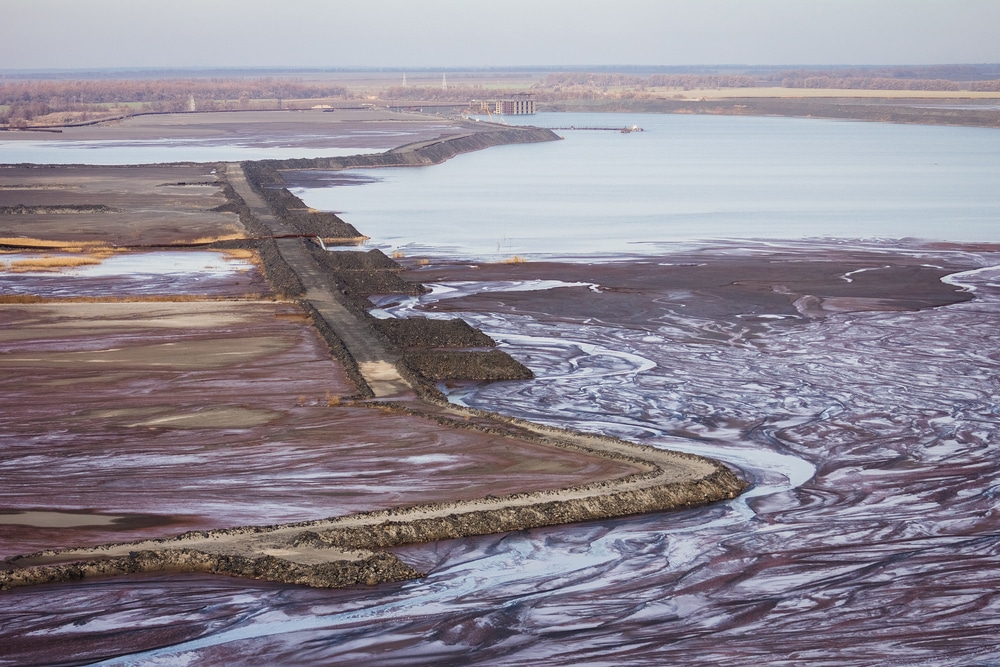
Achieving effective dust control for tailing dams can be real a headache for mine operators. Control measures not only need to be cost-efficient, but operationally effective too.
In this article, we’ll take a look at how to best achieve dust control at tailing dam sites on an ongoing basis.
The challenge tailing dams present for dust control
Tailing dams are designed to permanently hold waste material which is produced during the process of grinding up and separating minerals from ore.
When waste material is pumped onto the tailings dam, the solids settle to the bottom and the water on top is re-claimed to be used again.
But once this left-over waste material has dried out, it is of an extremely fine consistency. If left exposed, the material will inevitably be picked up by the wind and turned into dust.
To compound this issue, walls of tailing dams are often raised to keep up with increased mining production. As the walls of a tailing dam are raised, the more susceptible the material is to high wind erosion.
A mine site may have plans to rehabilitate a tailing dam with vegetation in the future but for as long as that has not been done, the tailings dam will emit dust to neighbouring settlements on windy days. Some tailing dams may also contain valuable resources which could be recovered at a later date.
Regardless of future plans, the dust from tailing dams needs to be dealt with in the meantime. This is because:
- Dust can have adverse environmental and health effects on neighbouring communities.
- The airborne particles and contaminants can also have an impact on the surrounding environment as well as on the health of workers on site.
Managing dust by covering tailings dam with gravel or wetting the surface using water are not always practical or cost-efficient solutions, especially over such a large surface area.
Spraying a bonding agent over the dry waste material to form an erosion resistant “crust” is widely considered to be a highly effective and cost-efficient measure for tailing dams.
Recognising the effectiveness of such spay-on measures, Dust-A-Side has a suitable solution called AquaTarp.
Ideal for use on tailing dams, AquaTarp works to provide enhanced soil binding and dust control properties.
How AquaTarp works to control dust at tailing dams
AquaTarp is a solvent-free, water and surfactant based emulsion of co-latex polymer. Once diluted with water, it can be sprayed on the top layer of a tailing dam prior to the next layer being pumped in.
The presence of acrylic matter in the formulation helps to bind fine dust particles that can quickly become airborne at the slightest breeze.
When sprayed on the dry waste material in tailing dams, the crusting effect of the product produces a surface seal that exhibits good wind and water erosion resistance. It prevents dust particles from being emitted into the atmosphere as well as sediment run-off.
This crust will effectively “lock down” the top surface layer for a period of approximately 6 – 12 months depending on weather conditions and material properties.
The use of AquaTarp is a much more cost-effective solution compared to repeatedly wetting the surface using water. Water alone can’t form an impenetrable crust and has high operational costs such as pumping and irrigation cost and has to be reapplied daily and at times twice a day depending on meteorological conditions.
AquaTarp can easily be re-applied when the walls of a tailing dam are raised to ensure ongoing dust control.
Want to learn more about dust control for tailing dams at your site?
To learn more about AquaTarp and our other dust control solutions, contact the experts at Dust-A-Side today.
We’ll happily supply you with an obligation-free report to design a dust control system tailored specifically to your needs.
Call us now on +27 12 648 8900 or simply click here to contact us.
![DAS_South Africa-Logo_Y[P]_SA DAS_South Africa-Logo_Y[P]_SA](https://news.dustaside.com/hs-fs/hubfs/DAS-South%20Africa/SA%20Logo/DAS_South%20Africa-Logo_Y%5BP%5D_SA.png?width=670&height=175&name=DAS_South%20Africa-Logo_Y%5BP%5D_SA.png)

